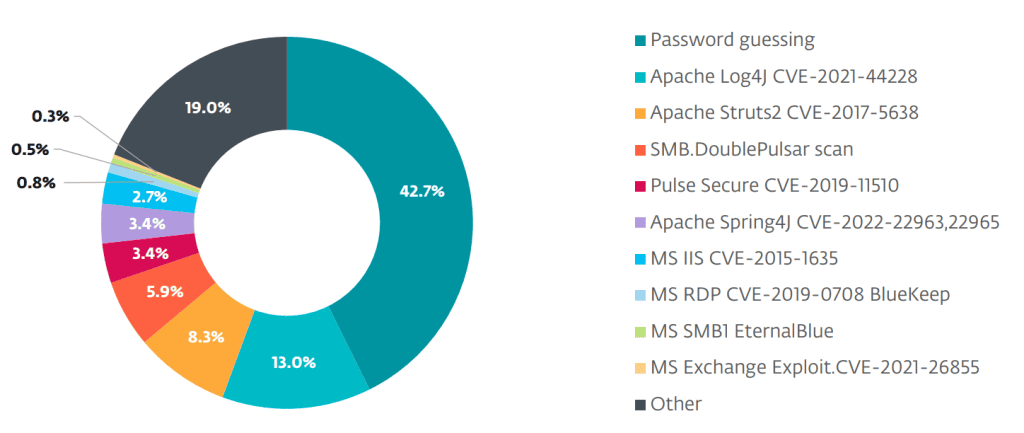What is a Brute Force Attack?
A brute-force attack is a trial-and-error method hackers use to guess login information, and encryption keys, or find hidden web pages.
In a brute force attack, an attacker tries as many combinations as possible, systematically incrementing through all possibilities until the correct password is discovered. This can be done manually, but it is usually automated using specialized software tools designed for this purpose.
An increased reliance on information technology has led to a significant rise in cyberattacks, particularly brute force and password guessing attacks from 2021 to 2023.
(Reference: ESET Threat Report H1 2023)
Types of Brute Force Attacks
There are several types of brute force attacks that attackers can use to attempt to gain unauthorized access to systems or data. These different types of brute force attacks can be used individually or in combination, depending on the specific scenario and the attacker’s resources and goals:
Simple Brute Force Attack: This represents the simplest form of brute force attack. The attacker systematically tries all character combinations for a password or encryption key. Effective against short or weak passwords but impractical for longer, complex ones.
Rainbow Table Attack: The attacker creates and stores a “rainbow table” of password hashes for common passwords. This enables them to swiftly find the plaintext password for any hash in the table, bypassing the need to brute force each hash separately.
Mask Attack: a mask attack targets passwords matching a specific pattern, enabling users to bypass unnecessary character combinations and shorten brute-force password recovery time. This can be more efficient than a simple brute force attack when certain password patterns are known or suspected.
Dictionary Attack: Attackers opt for pre-made lists of common passwords, words, phrases, and character combinations instead of exhaustive attempts. These “dictionaries” may comprise leaked password databases, popular keyboard patterns, or variations of common words.
Reverse Brute Force Attack (Credential Stuffing):This tactic shifts focus. Instead of aiming at a single account with diverse passwords, attackers utilize known leaked passwords from breaches and test them against numerous usernames or email addresses. This exploits instances of password reuse across different platforms.
Password Spraying: Similar to credential stuffing, employs a restricted range of common passwords, often leaked ones, across a wide array of usernames or email addresses. The attacker targets accounts where users have reused weak passwords, aiming to gain unauthorized access.
Keystroke Logging (keylogging): Is the process of capturing (logging) keystrokes on a keyboard, often done discreetly, without the user’s knowledge of being monitored.
9 Techniques to Reduce Login Brute Force Attacks
There are several techniques that can be employed to reduce the risk and impact of brute force attacks against login systems. Let’s discuss the 9 ways on how to avoid brute force attacks.
How to avoid brute force attacks:
-
- Strong Password Policies: Enforce strong password policies that require long passwords (at least 12-14 characters) with a combination of uppercase, lowercase, numbers, and special characters. Longer and more complex passwords increase the number of possible combinations an attacker must try, making brute force attacks much more difficult.
- Account Lockout: Implement account lockout policies that temporarily lock an account after a certain number of failed login attempts (e.g., 3-4 attempts) for a specified duration. This prevents an attacker from continuing to guess passwords indefinitely.
- CAPTCHA or Other Challenge-Response Tests: Integrate CAPTCHA or other challenge-response tests into the login process, which requires the user to prove they are human and not an automated bot. This can slow down brute force attacks significantly.
- Multi-Factor Authentication (MFA): Implement multi-factor authentication, which requires an additional factor (e.g., a one-time code sent to a user’s phone) in addition to the password. This additional layer of security makes it much harder for an attacker to gain access, even with a valid password.
- IP Address Monitoring and Blocking: Monitor and block IP addresses that have multiple failed login attempts from the same source. This can prevent an attacker from continuing their brute force attack from the same IP address.
- Delayed Responses: Introduce deliberate delays (e.g., a few seconds) between failed login attempts. This can significantly slow down the rate at which an attacker can try different password combinations.
- Honey Traps or Deceptive Responses: Set up honey traps or deceptive responses that lead an attacker to believe their login attempts are successful, while in reality, they are being monitored and blocked.
- Password Salting and Hashing: Store passwords using salting and secure hashing algorithms instead of plain text. This prevents an attacker from easily comparing hashed passwords against pre-computed lists of common password hashes.
- Monitoring and Logging: Implement robust logging and monitoring systems to detect and alert on potential brute force attack patterns, allowing for timely response and mitigation.
Windows Password Guidelines: Updated Best Practices for 2024
Why Server Hardening Should be Top Priority
While techniques like strong passwords and honeytraps can hinder brute force attacks, server hardening offers the most comprehensive defense. Server hardening addresses the root cause of the vulnerability rather than relying solely on techniques that mitigate the attack’s impact.
By hardening the system’s authentication mechanisms, it becomes significantly more difficult for attackers to gain unauthorized access through brute force methods. While the techniques mentioned above can reduce the effectiveness of brute force attacks, they are temporary solutions in the short term that do not eliminate the underlying weaknesses in the system’s security posture. Hardening, on the other hand, directly strengthens the system’s defenses, making it much more resilient against brute force attacks and other types of unauthorized access attempts.





